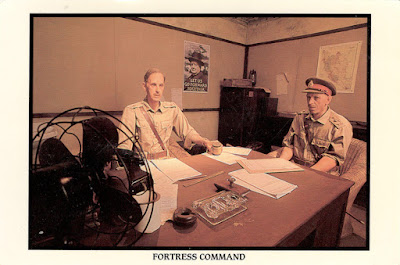 |
| 3174 The Gate of Fort Canning |
Between 1859 and 1861, a fort was build on a small hill located in the southeast portion of Singapore, to defend the harbour. It was named Fort Canning after Viscount Charles John Canning, who was then Governor-General and the first Viceroy of India. The fortifications were regarded as a failure from the beginning, as ships could easily get close enough to destroy the town and remain out of range of the fort’s guns. Moreover the lack of a water supply rendered the fort useless as a place of refuge.
 |
| 1851 Lt. General Arthur Percival (General Officer Commanding of the British land forces in Malaya and Singapore) and another British Officer in Battle Box |
In 1907, the old fort was demolished, and in 1920's a military headquarters was built with underground rooms serving as operations centre. Completed in 1938, the Battle Box comprised 30 rooms and had its own generator. By 1941, it was considered to be too small for its intended use, and a new Combined Operations Headquarters was build. The Battle Box remained the Headquarters of Major General Frank Keith Simmons, who was responsible for the defence of Singapore Island.
The decision to surrender Singapore to Japanese was made by Lieutenant-General Arthur Percival, General Officer Commanding of the British land forces in Malaya and Singapore, in a meeting on the morning of 15 February 1942, which held in the Commander, Anti-Aircraft Defence Room of the Battle Box. Singapore was considered an impregnable fortress, being nicknamed the "Gibraltar of the East". When Japanese Army conquered it in only 8 days, Winston Churchill considered this "the worst disaster and largest capitulation in British history."
The Battle Box having remained empty since the war, and was sealed off in the late 1960s due to safety concerns. The area became known as Central Park in 1972 when the land previously used by the British armed forces was combined with King George V Park, and was renamed Fort Canning Park in 1981. Rediscovered by a journalist in 1988, the Battle Box was developed into a museum, depicting the final days of the battle of Singapore. Through the use of audio-visual effects and high-quality animatronics visitors can relive the morning of 15 February 1942.
About the stamps
On the postcard 1851
The stamp is part of the second set of the series Vanishing Trades, about which I wrote here.
On the postcard 3174
The stamp is part of the series Scenes of the local markets, issued on April 18, 2012. All four stamps have the same face value, 80 cents.
References
The Battle Box - Wikipedia
The Battle Box - Official website
Sender 1851:
Sent from Singapore, on 30.03.2015
Sender 3174: Pumipat
Sent from Singapore, on 12.10.2017


No comments:
Post a Comment